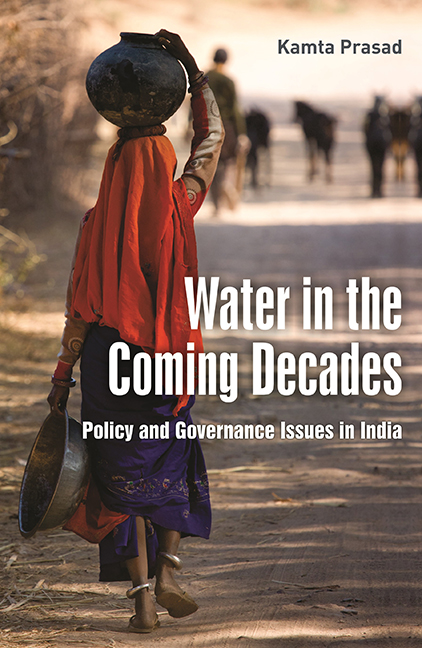Book contents
- Frontmatter
- Dedication
- Contents
- List of Tables
- List of Abbreviations
- Preface
- Acknowledgements
- Section I Overall Perspectives
- Section II Situational Analysis
- Section III Socio-economic, Institutional and Environmental Aspects
- Section IV Technological Options
- Section V Concluding Observations
- References
- Index
4 - Availability and Requirement of Water in India
Published online by Cambridge University Press: 13 July 2022
- Frontmatter
- Dedication
- Contents
- List of Tables
- List of Abbreviations
- Preface
- Acknowledgements
- Section I Overall Perspectives
- Section II Situational Analysis
- Section III Socio-economic, Institutional and Environmental Aspects
- Section IV Technological Options
- Section V Concluding Observations
- References
- Index
Summary
This chapter provides a situational analysis of both the availability and requirement of water in India so as to get an idea of its adequacy. This information is critical for analyzing policy and governance issues. It also highlights factors affecting both the availability and the requirement, including the emerging phenomenon of climate change. It draws attention to uneven distribution of water and indicates areas suffering from water scarcity.
Availability of water
Despite its criticality, there is no definite information on how much water is available in India as can be seen from divergence in estimates for surface water given below. The difficulties faced in making precise estimates of the availability of water have been explained in Chapter 13. Currently, the most widely accepted figure is 1,869 km3, estimated by CWC (1993).
The figures given in Table 4.1 include water which is not available for use, since a part of it goes back to the atmosphere as evaporation or evapotranspiration, a part seeps into deep layers of ground where it may be entrapped, while a part flows to the sea/ocean. Hence, it is the availability of utilizable surface and groundwater which is relevant. Utilizable surface water has also been estimated from time to time, e.g. by the Second Irrigation Commission in 1972, National Commission on Agriculture (1976), Dr K. L. Rao and CWC (1993). The latest estimate is by NCIWRD (1999) which gave a figure of 690 km3, another 433 km3 of utilizable water has been assessed to be available from groundwater sources, thereby making a total of 1,123 km3.
The availability may, however, be less if the underlying assumptions turn out to be different. ‘Harnessing of 690 km3 of utilizable surplus water is possible only if matching storages are built up to the required extent.’ But, as of May 2010, the storage capacity has been only 396.57 km³ from projects completed, under construction and under consideration, leaving a balance of 293.43 km³. Additionally, there are problems with regard to the availability of suitable sites for reservoirs and opposition to their construction by powerful lobbies. Prospects appear dim for trans-basin transfer of water, which is estimated to add to utilizable water resources by approximately 200 km3 if all the schemes proposed in the National Perspective Plan fructify.
- Type
- Chapter
- Information
- Publisher: Foundation BooksPrint publication year: 2014

